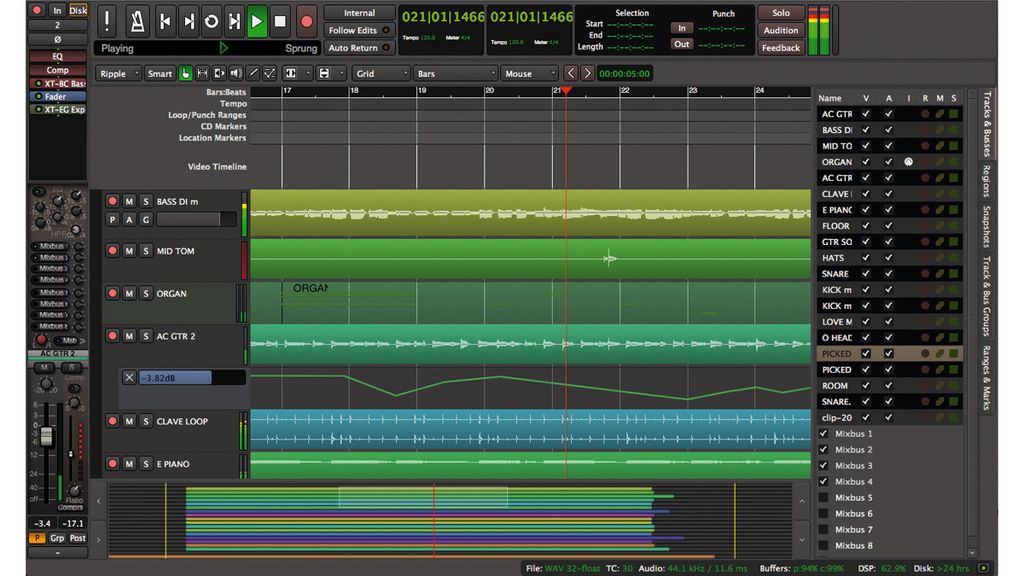
- #Harrison mixbus reviews update
- #Harrison mixbus reviews license
- #Harrison mixbus reviews plus
- #Harrison mixbus reviews series
- #Harrison mixbus reviews download
Whereas most analog consoles have group assignments and aux sends, those have more or less been combined here to feed the 12 mix busses. The setup of how the busses are fed by the tracks in Mixbus is interesting. The right side of the window displays the 12 subgroups, the main stereo group, and the monitor section (more on that later). The left side of the mixer window displays lists of channel strips, groups, and user-favorite plugins. Any latency here was either unnoticeable or didn’t affect the audio in any negative way. In practice, I only did this when a track needed extra little reverbs and delays. Should you need additional aux tracks for submixing or time-based effects, you must account for any incurred latency on your own. Harrison automatically accounts for the latency of all tracks feeding towards the submixes, and ultimately the stereo bus as well. The 12 subgroups are designed to act as submixes or time-based effects tracks. Harrison gives you an unlimited number of audio, MIDI, and auxiliary tracks, which then feed into a possible 12 subgroups and/or the main stereo bus. While there is quite a bit of flexibility in setup and routing, there is also a designated signal flow that is used: channels feed into subgroups, which in turn feed the main mix, like on a console. The other main window is the Mixer window. The right side of the window displays all session lists at a glance, such as tracks, busses, regions, snapshots, groups, etc. The left side of the window can display the currently selected channel strip, making work on all aspects of one particular track very easy. Tracks in the Editor window are laid out in the standard fashion. This timeline allows you to bounce out any pre-defined range, which is great for mixing live albums, or exporting a portion of a mix as a clip or preview. Many timeline lanes show common units (min:sec, bars & beats, timecode, tempo, meter, etc.), but there are also some very useful lanes such as Range. Across the top are the transport controls, editing tools, playback modes, counters, selection and song map. The Editor window is laid out in a mostly comfortable and familiar fashion. Sadly, there is no way to use the transport as a separate window, which would also be nice. Using a touchscreen as an additional monitor featuring this window would make recording and overdubbing with multiple musicians much easier to wrangle. Additionally, these meters have buttons for input, record enable, solo, and mute. One of my favorites is the meterbridge, a fully-sizable group of meters that can be set to a large number of metering standards used around the world, in broadcast, film, and music.

There are of course other windows that can be opened. Like most DAWs I’ve used, Mixbus has a few different screens to work from, mainly the editor view representing our multitrack, and the mixer view, representing the console. It even supports sync for video and can lock up with other systems.

All aspects of music making can be accomplished inside Mixbus this includes recording, mixing, sequencing, using MIDI tracks and virtual instruments, etc.
#Harrison mixbus reviews update
The v2.4 update email also provided a coupon allowing existing customers to switch to a subscription without the initial $49 payment.While Mixbus may have analog dreams, it is still very much a full-fledged DAW in terms of its feature set. Subscribers received a free copy of the XT-BC Bass Character plug-in.

The subscription provides ongoing benefits (including at least 50% off new plug-ins) and fosters continued development for Mixbus and the Ardour open-source workstation platform.
#Harrison mixbus reviews plus
Mixbus can be purchased for $149 or, customers can purchase a “subscription” for $49, plus a recurring fee of $9 per month. For detailed information about Mixbus, please visit the Mixbus website.
#Harrison mixbus reviews download
Current customers received a link to download the program update via e-mail. This new plug-in is compatible with Mixbus v2.4. For more information, watch the introduction video below. The XT-BC can be used to beef up a thin recording, subtly change the tonality of an instrument, or attenuate the fundamental of a bloated bass track that is overshadowing other instruments in the low end of a mix. Unlike a traditional EQ, the XT-BC is “frequency-agile,” meaning that it tracks the pitch of the sound, and applies EQ specifically to the note’s fundamental or overtones. It is designed to musically alter the tonality and character of bass instruments such as electric bass, stand-up bass, and synth bass.

This plugin is an innovative new equalizer from Harrison’s R&D department.
#Harrison mixbus reviews license
Mixbus users can purchase a license ($109) from the Harrison Mixbus store. Mixbus subscribers received this plug-in for free.
#Harrison mixbus reviews series
This update brings numerous fixes, as well as a new addition to Harrison’s XT series for Mixbus: the XT-BC Bass Character plug-in. Harrison is proud to announce the availability of the FREE v2.4 update for Mixbus.


 0 kommentar(er)
0 kommentar(er)
